Converting Attic to Conditioned Space
Zone 3a
In the process of planning a remodel on a house built in the 1950s and looking into my options for converting the attic into a conditioned space, but keeping it as a vented roof.
The house has soffit and ridge vents on an existing roof that is only ~5yrs old The roof is a basic composite roof with a tar paper underlayment as opposed to a membrane which has me concerned about having spray foam applied directly to the underside of the roof.
I have been considering an insulation assembly that would be a combination of foil-faced poly iso sheets offset from the roof deck 1.5in and then close cell spray foam to build out the insulation thickness and bond the assembly together.
My thought process is it allows the existing soffit & ridge vents to continue to function, adds a radiant barrier and the open space would allow any potential roof leak some means of ability to dry.
Any pitfalls to using such an assembly?
GBA Detail Library
A collection of one thousand construction details organized by climate and house part











Replies
Your assembly should work fine from a building science point of view. I think it would cost more than necessary; the polyiso isn't doing anything that a conventional vent baffle wouldn't provide.
Your assembly also involves much higher greenhouse gas emissions than necessary, mainly due to the blowing agents in the spray foam but also due to the embodied carbon in both the rigid and sprayed foam. You can spec HFO-blown foam, which has about 1/4 the climate impact of conventional HFC-blown foam.
I care about my contribution to climate change so if possible I would use a lower-impact assembly such as a vented cellulose roof, furring down the rafters if necessary to reach R-value targets. When venting is not possible or when it's not possible to reach code-minimum R-values without it, foam is a good option.
A radiant barrier is only worth about R-1 so unless you have no other insulation it's not worth considering, in my opinion.
The thought process on the radiant barrier is if I am going to go with polyiso getting a foil facing is of no additional cost and since I am effectively creating a channel for it to reject heat back into it made the most sense.
I also expect it would work well. It would work even better if you didn't put a vapor barrier on the exterior. Ie, had a better interior/exterior perm ratio that would allow the small amounts of moisture entering from the interior to better dry into the vent. Eg, replace foil faced polyiso with unfaced EPS or plywood.
If you switch to cellulose, you definitely don't want low perm baffles. And as I read it, code (R806.1) doesn't permit an air barrier baffle at all (because it creates an unvented enclosed rafter space).
I agree your proposed assembly would work, but I don't think it's an efficient assembly to build. The polyiso isn't really adding anything in terms of insulation here, since the spray foam would be able to handle that function just fine by itself. You'd need a baffle to maintain your vent channel though, so you would need something there. You could use thin OSB or plywood here, or something like LP Techshield if you want a radiant barrier (which adds a little, but it's not a huge improvement).
I would use open cell spray foam if you go with spray foam here. The reason is that open cell can be installed then trimmed flush, closed cell is going to be underfilled and left lumpy. Open cell uses less material per unit thickness too (so it's greener), and the vapor permeabality issues of open cell in roof assemblies don't come into play here because this is a VENTED assembly. If you wanted to build this assembly, I would go with LP Techshield and open cell spray foam.
All that fun stuff said, I pretty much agree with Michael here -- you don't really need to be using spray foam. I use spray foam in only a few niche locations, like UNvented roof assemblies, where it's really the best option. In your case, I would probably use thin polyiso as a baffle material, then dense pack cellulose and furr the rafters out enough to get the thickness you need. You could probably keep those furring strips somewhat open too to limit thermal bridging, or put a layer of rigid foam on the interior side of the assembly. I taped layer of polyiso under the rafters would keep interior moisture out of the roof assembly, for example, reducing the amount of moisture the vent channel would have to deal with. Batts could be made to work well here too.
Bill
One of the main reasons for the polyiso/closed cell is the house has a 4:12 roof w/ 2x6 rafters and is only 21ft deep. I still need to have room for the HVAC equipment so my options to achieve a reasonable R-value are limited to products that have the highest r-value per inch.
My thought process on the polyiso baffle is I am able to achieve the vent I am looking for with a product that won't rot if exposed to moisture and it adds to the r-value in doing so.
The reason for the spray foam is the space is already tight (hip roof) and instead of having to rely on perfectly applied tape & can foam to achieve a good air seal I can foam the assembly, tie everything together and get the desired seal. Plus I have to have the rim joist sprayed as well as part of the Insofast basement wall assembly.
I do welcome any suggestions with that context in mind.
You may find that the high-on-paper R value of closed cell spray foam won't make as much practical difference in your project as you'd think. The usual reason for this is the underfilled installations that are typical. Yes, closed cell is higher R per inch, but you end up with less inches of fill (thickness) of closed cell compared to open cell. You typically have around an inch or so of unfilled area in deeper applications like this, so keep that in mind. Open cell is typically OVERfilled, then trimmed flush, so you actually get a full thickness layer of material.
If you want to use polyiso as a baffle material, I'd stick with 1/2" polyiso here -- the spray foam will be doing most of the insulating work regardless, so save some money with the thinnest common size of polyiso since it's really only acting as a baffle here anyway. Any spray foam displaced by the polyiso is "made up for" by the polyiso's own R value. The polyiso isn't really giving you an R value boost.
If you need maximum clearance underneath, you may want to consider going with an unvented assembly using closed cell spray foam. That will get you the highest R value in the least space. This would be how unvented cathedral ceilings are often insulated.
Bill